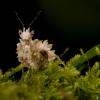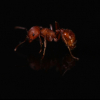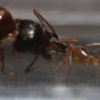Hi,
Last August I caught a few Lasius queens. 4 of which are Lasius neoniger which all have a nice batch of eggs and larvae right now. I also caught, what I think is a Lasius alienus queen. As of last year before hibernation she had her first workers (7 of them). They're now out of hibernation with a nice pile of intermediate developed larvae.
When will the larvae start developing?
Would they be developing already?
Is this normal?
I'm a nervous antkeeper...
Thanks.
-AntsMaryland

















